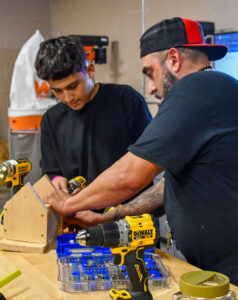4 Stats That Show the Exploding Demand for Career and Technical Education
 Career and technical education (CTE) has historically been a staple in American schools. Once called vocational education, these types of classes taught students specific skills that were tangible and useful in a future career.
Career and technical education (CTE) has historically been a staple in American schools. Once called vocational education, these types of classes taught students specific skills that were tangible and useful in a future career.
While this type of skills-focused education had fallen into the background of school priorities in recent decades in favor of college prep-designed coursework, interest and demand in CTE has exploded once again over the last few years. Both economic and cultural shifts have resulted in some evolving mindsets that have brought the importance of teaching these valuable technical skills back to the forefront.
Here are four key stats that show the growing momentum for career and technical education – and how high schools and their districts can act now to add or expand these programs to meet this renewed demand.
1. 63% of high schoolers think about Career and Technical Education (CTE) in the same way they think about college as options for higher education. (Source)
Speaking directly to the evolving mindset of current students, nearly two-thirds of high schoolers now look at both CTE and college as equally worthy pathways to a career. While factors such as time, cost and scope can vary greatly between these differing paths, many students see both as a valid means to find success.
2. 74% of parents strongly support their students taking elective courses in middle or high school that teach technical or occupational skills. (Source)
Students aren’t the only ones with an interest in learning more technical skills. Parents also want their children to take advantage of the courses at their schools in CTE clusters like construction, agriculture and manufacturing. Almost three-quarters of parents strongly support their students participating in these skills-focused electives.
3. 86% of parents and students say they wish they could get more real-world knowledge and skills during high school. (Source)
Many families have a keen interest in CTE, but arguably even more families are frustrated with the current lack of practical education currently being taught in their school system. While most high schools have focused on preparing students to go to college, students and their parents overwhelmingly feel like they have not sufficiently prepared students for the “real world.”
4. 94% of parents strongly (60%) or somewhat approve (34%) of expanding access to career and vocational programs. (Source)
While interest in technical skills is clear, it’s also apparent that the number of opportunities to learn those skills is coming up short in many schools. The vast majority of parents support creating more of these opportunities by expanding the availability and quality of local CTE programs.
How High Schools Can Build Their CTE Programs
With the need for robust career and technical education becoming ever more apparent, high schools and school districts may be looking for ways to start or strengthen their own CTE programs.
One of the primary considerations for expanding CTE is funding availability. Luckily, both federal and state funding options for CTE have grown in recent years, as policymakers acknowledge the importance of these programs. At the federal level, Perkins V funding allocates around $1.4 billion each year for the development and implementation of career and technical education programs. Additional funding is available through some state budgets; one 2023 study found that 27 states had increased funding for secondary CTE over the previous decade. Schools with access to CTE funding can capitalize on this opportunity to offer high-demand occupational skills education to their students. These schools may choose to build their own CTE programs from scratch, or they could partner with local industry groups or third-party education providers to establish new learning opportunities.
For example, a school interested in teaching skilled trades like carpentry, electrical, HVACR or agricultural technology could get sponsored by a local contractor or other postsecondary organization to become accredited with the National Center for Construction Education and Research (NCCER), the nation’s leading nonprofit construction education foundation. NCCER is recognized by many state Departments of Education and is designed to meet the standards and requirements schools need to secure federal and state funding. NCCER can offer a complete suite of turnkey resources for CTE programs, including craft training curriculum, testing, industry-recognized credentials, career exploration tools and job placement connections. The NCCER credentialing model also supports vertical articulation with community colleges, registered apprenticeships and other postsecondary opportunities, helping high school construction programs be even more effective at building a pathway to success for their students.
For schools that do not have an industry sponsor, or may have other challenges such as limited access to funding or experienced craft instructors, it’s still possible to start a program. Starter initiatives such as NCCER’s High School Builder Program help make CTE more accessible by helping schools overcome the obstacles of setting up a construction CTE program for the first time. With guidance from experienced program developers, instructor training, educational tools and resources, and opportunities for funding benefits made possible by generous donors, NCCER’s High School Builder Program helps support schools committed to offering construction education.
As the emphasis on teaching practical occupational skills continues its return to the public paradigm, CTE programs will be a leading contributor to this new era of education.
Interested in learning more about implementing construction education in high schools? Contact our Workforce Development team to discuss your goals and find the right solution for your program.

